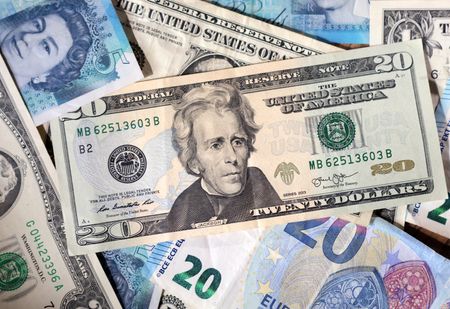By Kevin Buckland and Lucy Raitano
TOKYO/LONDON (Reuters) -The U.S. dollar ticked marginally higher against other major currencies in calm market trading on Thursday, but stayed close to multi-week lows as bets that the Federal Reserve will resume cutting interest rates next month rose.
Bucking the trend was the yen, with the dollar touching a three-week low against the Japanese currency after U.S. Treasury Secretary Scott Bessent suggested the Bank of Japan needs to raise rates again soon, while the Fed cuts aggressively.
A hot producer price index for July saw the dollar spike marginally higher in afternoon trading, but markets were largely steady during morning trading in Europe.
“This is typical summer markets vibe. Now we’ve moved past the CPI print on Tuesday, there aren’t any major events on the horizon until Jackson Hole next week,” said Michael Brown, senior research strategist at Pepperstone.
Brown added that the market is now dead-set on the Fed delivering its next rate cut in September.
“We’re probably going to see a week or so of these sort of trading conditions, relatively choppy, relatively indecisive, albeit at the same time with a bearish dollar bias in the mix.”
Fed rhetoric has turned broadly more dovish on signs of a cooling U.S. labour market, while President Donald Trump’s tariffs have yet to significantly increase price pressures.
Traders see a Fed rate cut on September 17 as a near certainty, according to LSEG data, and even lay around 7% odds on a super-sized half-point reduction.
“For the markets, it’s not even a matter of if the Fed cuts interest rates in September, it’s a question of how much,” said Kyle Rodda, an analyst at Capital.com.
“Signs of a downturn in the labour market have pushed futures to bake in a series of rate cuts before the end of the year.”
The Fed also continues to be under intense political pressure to ease.
Trump has repeatedly criticised Fed Chair Jerome Powell for not cutting rates sooner, even threatening to oust him before Powell’s term expires next May.
Treasury Secretary Scott Bessent called on Wednesday for a “series of rate cuts,” and said the Fed could kick off the policy easing with a half-point cut.
Francesco Pesole, FX strategist at ING, said a 50-bps rate cut is not very realistic right now. “In order for the market to price 50 basis points in, we would probably need some indication from other Fed members that they are somewhat open to the idea.”
Traders are now looking ahead to U.S. PPI figures for July due later in the session.
“If that comes in soft or below expectations that can add a little bit of easing,” said Pesole.
Bessent said the Bank of Japan had gotten “behind the curve” by delaying rate hikes.
“Bessent’s comments are having a strong impact on USDJPY,” said Norihiro Yamaguchi, an economist at Oxford Economics.
At the same time, “gains in the yen are being accelerated by low liquidity in the market as fewer market participants are around this week” due to the Obon holiday, he said.
The U.S. dollar dropped as much as 0.8% to 146.22 yen on Thursday, its weakest since July 24, and was last down 0.39%.
The euro was down 0.23% at $1.167675, coming off Wednesday’s peak of $1.1730, a level last seen on July 28.
The pound declined 0.1% versus the dollar, earlier propped up by UK GDP data that showed the economy slowed less than expected in the second quarter.
Neil Wilson, UK investor strategist at Saxo Markets, said recent UK data have been poor, yet wage growth is still strong.
“Inflation remains too high and growth is failing – we are into stagflationary doom loop. This would be bad enough if it were not also for the fact we face a fiscal black hole that is going to mean higher taxes,” he said.
Bitcoin earlier hit its first record peak since July 14, pushing as high as $124,480.82 before trimming gains and was last down 2.66% at around $119,633.
Bitcoin was already underpinned by increased institutional money flows this year in the wake of a spate of regulatory changes spearheaded by Trump, who has billed himself the “cryptocurrency president.”
(Reporting by Kevin Buckland in Tokyo and Lucy Raitano in London; Editing by Shri Navaratnam; Editing by Sam Holmes and Jane Merriman)










